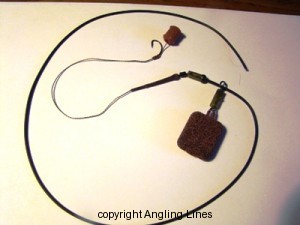In this post David Harding explains why he recommends running rigs on his lake;
You can imagine my thoughts when asked to write an article on the running rig, firstly by trying to remember when I first used it. My mind went back to as far as I can remember to Lincoln 1958 and it consisted of a 18” end rig of soft material with a ½ oz lead (no 2 or 3oz leads then!) running along the main line. In fact this was the only rig used at the time but I must say it was a bugger to cast (ie tangles) and there is nothing worse than sitting looking at your bobbins and wondering did it land okay and is it tangled?
 Getting back to the modern day running rig which I use all the time now and being fortunate now owning my own lake (mind you it’s has taken 58yrs!) I now recommend it to all my lads and it catches a lot of fish.
Getting back to the modern day running rig which I use all the time now and being fortunate now owning my own lake (mind you it’s has taken 58yrs!) I now recommend it to all my lads and it catches a lot of fish.
I will firstly explain why I think this rig works so well. The rig consist of a 12” soft hook link. I prefer soft hook links for this rig because of freedom of movement with a balanced bait. In the old days we used Dacron (but tangle free it was not!) so I cured this by using plumbers freeze spray. This I used to spray my end rig and it used to freeze it for casting. On entering the water after 10 seconds it unfroze but left me in a good frame of mind back on the bank.
Getting back to the fundamental materials of the actual set-up; materials needed for this is a 12” soft hook link, a number 8 swivel & 1 metre of tubing. The tubing is threaded onto the main line firstly with a 2oz lead attached to a decent size run ring and buffer bead. The buffer bead is threaded on the tubing after the run ring. Some people use a stop at the end of the tubing but I prefer complete free running leads, this I find the carp love and the runs are really fast and I believe it really catches fish. But I must say it is a set-up you cannot leave & go and talk to your pals.
I prefer to use non in-line leads because I believe if you cast a inline lead any distance on a soft bottom the rig goes into the silt/sand like a V shape and jamming the lead and hook link into the soft bottom , no longer becoming running. I use 2oz flat leads attached to my rigs these never stick in the soft lake bottom.
This is the most successful rig to start people on and on my water the simpler the rig works better and you will always have peace of mind as you cannot leave a carp tied up with a running rig. Always remember if you can share a little knowledge with the man next to you, do so. I myself always consider this a privilege
Good Luck!
David Powers Harding

Hello,Just came across your running rig set up,Can you tell me why you fell the need for tubing and do you feel it may have any adverse affect on indication I am not trying to pick holes in the rig I would just be interested in taking your opinion on board,Regards,Andrew.
Sorry ,Should have included other than anti tangle.
Hi Andrew,
I have been asked by Heather of angling lines to try and answer your question. The reason that I can see that tubing is required other than that of its ant-tangle properties, is the prorection to the fish. I do beleive that the tubing protects the scales on both mirror and common carp. Mono by itself can lift the scales on a fish as the fish is being played to the net due to the low diameter of the line and due to its hardness. The exta width of the tubing and the softness does protect these scales.
I personally do not likee useing running rigs. Occasionally running rigs can lead to very deep hook holds as the fish can be allowed to swallow the bait. Bolt rigs use the weight of the lead to put the hook home into the flesh of the carps mouth but running rigs depend on the angler striking the rod or extra tight lines. There is nothing worse when playing a fish than the lead running up the line towards the rod. The ideal situation in playing any carp is for the lead to drop off after a carp run, this allows you to bring the carp to the surface and away from any obsticals that could be on the lake bottom or weed.
I hope that this has answered your question
Paul Cooper